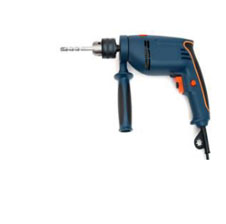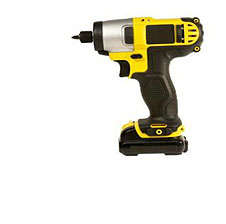Choosing The Right Drill
When choosing the right drill, it’s hard to know the right type to buy.
- Do you go for a powerful drill (corded) that has to be plugged into a power source?
- Or do you go for a battery-powered drill (cordless)?
Once you’ve decided to go cordless or corded, its time to decide what type of drill you need – like a impact drill, hammer drill or a drill driver.
Here you can learn about the pros and cons of different types of drills available on the market.
 Cordless Cordless
Cordless drills are a popular choice for general home and industrial use such as drilling holes or driving screws into wood and plaster. These battery-powered models are lightweight and easy to handle, there are no messy leads to get tangled up in. You must remember to recharge the battery before the next use!
It’s important to note that cordless drills don’t have as much power as corded drills, so if you’re looking for something that can drill bigger holes in concreteor masonry, you may want to reconsider
this option.
Take into consideration when choosing a cordless drill, how long it will last between charges. It can be frustrating having to wait for the battery to recharge. Look at the Amp Hours of the drill – the higher this rating, the longer it lasts. Also look at the Voltage – more volts means more power (but this means a heavier battery, making the drill harder to handle).
Check how many batteries come with the drill – unless you want to spend hours waiting for a recharge, it’s best to have a spare.
 Corded Drills Corded Drills
A corded drill plugs into a power point, making it more difficult to use around the house. Yet it is more powerful and reliable than its cordless options – this option is ideal for use in a workshop environment. It is also ideal for heavy-duty uses, such as drilling into concrete or masonry.
If you use this type of drill it is advisable that you use residual current device (RCD) to reduce the risk of electrocution.
Drill Drivers
This is your most affordable, versatile drill – and is commonly chosen by professionals and DIY’ers alike.
Drill drivers are commonly used for boring holes, and then driving or loosening screws. They usually have a couple of speeds and several power settings (torque), which gives you great control and can help you prevent over-tightening into the surface of the material.
Drill drivers can cope with drilling into wood, metal and interior walls (but not stone, concrete and masonry).
Corded Hammer Drills
Hammer drills not only spin, but also moves quickly in and out – as though it is being hit constantly with a hammer. With the added force of all this hammering, this drill is ideal for boring holes into concrete, stone or masonry.
This heavy-duty option is harder to handle than the drill driver. Remember, these are very loud and powerful. Personal protective equipment (PPE) should be worn i.e. earplugs, gloves, and goggles.
If you use this type of drill it is advisable that you use residual current device (RCD) to reduce the risk of electrocution.
Cordless Hammer Drills
Construction workers commonly choose this option and DIY’ers alike.
Take into consideration when choosing a cordless hammer drill, how long it will last between charges.
This option has all the characteristics as the corded version. All safety considerations should be taken when using the drill.
Personal protective equipment (PPE) should be used - gloves, goggles and earplugs.
Check how many batteries come with the drill – unless you want to spend hours waiting for a recharge, it’s best to have a spare.
 Impact Drivers Impact Drivers
An impact driver uses a hexagonal socket instead of the regular chuck bit, and these hex shaft bits are very easy to change.
Always remember to wear PPE whilst using this drill.
An impact driver is very powerful, and provides great control. It can be used for everything from carpentry to construction.
The impact driver is hugely popular amongst construction workers, and is becoming more and more popular amongst DIY’ers, too! Why? Well, it is
engineered to do one job – drive screws – and it does this faster and easier than any other tool on the market. It can drive screws, nuts and bolts intometal and wood in a flash.
Note that you can’t swap out between an impact driver and a hammer drill –they use different drill bits. |